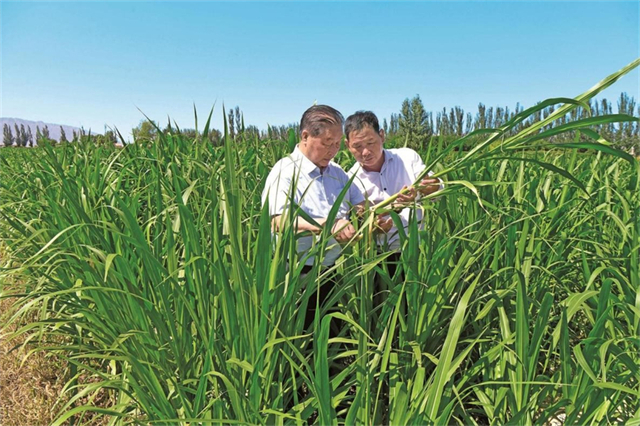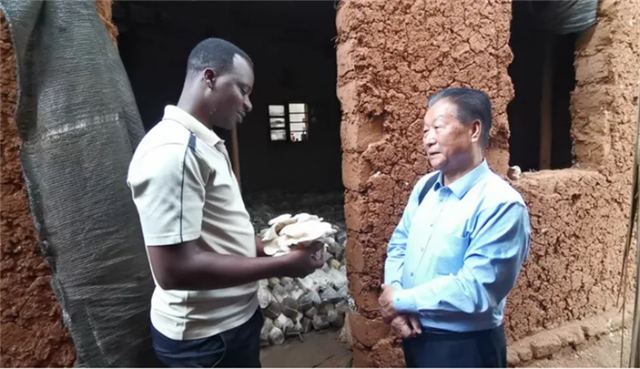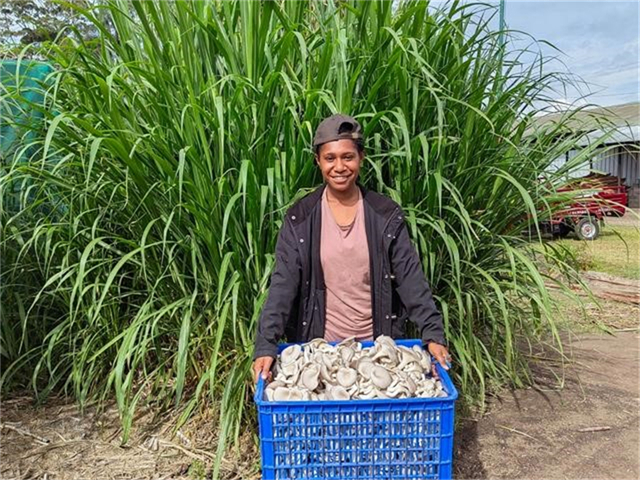China's Juncao grass leads to prosperity, happiness
What is Juncao grass?
In simple words, it is a type of tall herbaceous plant that can be used to cultivate edible and medicinal mushrooms.
In a greenhouse in Yuanyi village, Minning township, Yongning county of Yinchuan, northwest China's Ningxia Hui autonomous region, giant Juncao grass is growing, straight and tall, with plants over 3 meters high seemingly touching the roof of the greenhouse. The dense Juncao grass there looks just like a primitive forest.

Lin Zhanxi (left) checks the growth of Juncao grass in a science and technology innovation industrial park in Shizuishan, northwest China's Ningxia Hui autonomous region. [Photo by Lang Kai]
In 1997, Lin Zhanxi, chief scientist of the China National Engineering Research Center of Juncao Technology, known as the "father of Juncao," led a team to Minning township for poverty alleviation. The six boxes of Juncao grass they brought to the township were called "ecological grass," "fortune grass," and "happiness grass" by the locals.
When Lin visited Minning township again in 2010, the yield of fresh Juncao grass per mu (667 square meters) had reached 20 tons.
In a field in Gaozhao village, Pingfeng township, Xiji county, Guyuan of Ningxia, villagers were seen planting Juncao grass.
"Juncao grass is so good! It can be used as animal feed and also prevents wind and fixes sand," said villager Fan Jianzhi. The man has contracted 30 mu of land.
While marveling at the high quality of the Juncao grass this year, he took videos with his phone and forwarded them to villagers' chat groups. Mobilized by Fan, many villagers have reclaimed land and planted a total of 140 mu of Juncao grass.

Lin Zhanxi instructs a local farmer to cultivate mushrooms with Juncao grass in Rwanda. [Photo courtesy of the China National Engineering Research Center of Juncao Technology]
As a pioneer plant for ecological governance, Juncao grass can not only be used as feed for cattle and sheep, but also serves as a tool to conserve water and soil, prevent wind and fix sand.
In 1993, Lin planted Juncao grass on severely eroded land in Changting and Liancheng counties in southeast China's Fujian province. This achieved good results in water and soil conservation.
A year later, when he saw exposed riverbed and disrupted flow of the Yellow River in Shandong province in east China, he determined to bring Juncao grass to the Yellow River basin.
Later, he and his team stationed in the Ulan Buh Desert in Inner Mongolia autonomous region. After many failed attempts and replanting, the Juncao grass finally took hold and survived, which brought good governance to the drifting sands.
Today, Juncao grass is being planted in nine provinces and autonomous regions along the Yellow River.
"I have always hoped that one day, Juncao grass can play a greater role in ecological governance and contribute its part to building a strong ecological barrier on Earth, benefiting more future generations," said Lin.
"Juncao grass boasts a well-developed root system, high photosynthetic efficiency, and sound adaptability. It is drought tolerant, salt and alkali tolerant, and stress resistant. It can grow quickly on slopes, sandy areas, and alkaline land. It can also effectively improve saline-alkali soil," said Huang Guoyong, former head of a work team promoting poverty alleviation via Juncao grass in Ningxia.

A farmer in Papua New Guinea poses for a picture with the mushrooms cultivated with Juncao grass. [Photo courtesy of the China National Engineering Research Center of Juncao Technology]
"The development of Ningxia's animal husbandry industry needs massive corn. Giant Juncao grass has higher crude protein content than corn, and the yield of fresh giant Juncao grass per mu in Ningxia is about 3 times that of silage corn. Planting 20,000 mu of Juncao grass yields at least the equivalent of 60,000 mu of silage corn. This is equal to saving 40,000 mu of arable land," Huang told People's Daily.
The use of the plant today is far beyond its initial definition of "cultivate edible and medicinal mushrooms." It has become a "magical grass" that promotes ecological protection, increases farmers' income, advances sustainable development.
In Shizuishan, located at the end of the Yellow River Ancient Canalization Project in Ningxia, there are large areas of saline-alkali land with high soil salinity content and poor permeability, which make it difficult for many crops to survive. The severely saline-alkali land exceeds 117,000 mu, accounting for 5 percent of Shizuishan's arable land. Since Juncao grass was grown there, not only has the ecological environment improved, but the local green economy has also taken shape.
Guided by Lin, the first Juncao grass science and technology innovation industrial park was established in Shizuishan in April 2021. In just over two years, the industrial park has built a research building, intelligent workshops covering an area of 12,000 square meters, and more. It is currently working to build a full industrial chain of Juncao grass.
"Planting Juncao grass conserves water and fertilizer, eliminating the need for pesticides. It reduces costs by over 200 yuan ($21.73) per mu while improving efficiency, generating direct benefits of 4,000 yuan per mu. Further benefits can be realized through animal husbandry, mushroom farming, and applying fertilizer back to the fields, increasing the value per mu to over 10,000 yuan," Huang said.
The Juncao technology was born and developed for poverty alleviation, said Lin. According to him, Juncao grass is applied today in 12 industries of six areas, including power generation and animal husbandry. Although the technology was invented by China, Lin hopes it can further benefit the whole world in the future.
Today, Juncao grass has also taken root in many countries and regions in Asia, Africa and Latin America. In countries like Papua New Guinea, Juncao grass is nicknamed "Chinese grass" by the locals. Under the unremitting efforts of Lin and his team, the Juncao technology has been introduced to 106 countries and regions worldwide, helping increase income for people in many impoverished areas.
























